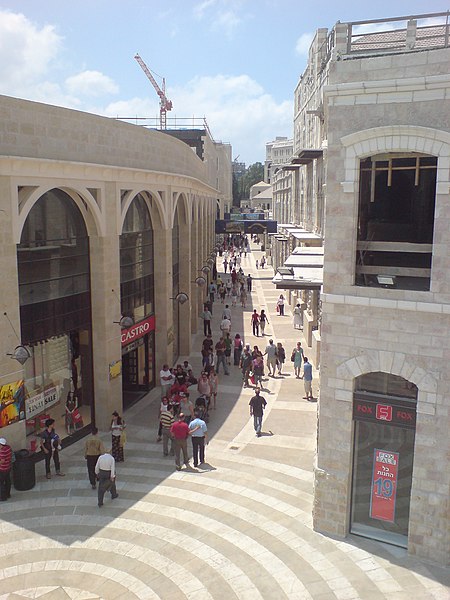Mamilla Mall, also called Alrov Mamilla Avenue, is an upscale shopping street and the only open-air mall in West Jerusalem. Located northwest of Jaffa Gate, the mall consists of a 2,000-foot (610 m) pedestrian promenade called Alrov Mamilla Avenue lined by 140 stores, restaurants, and cafes, and office space on upper floors. It sits atop a multi-story parking garage for 1,600 cars and buses, and a bus terminal. Designed by Moshe Safdie and developed by Alrov Properties and Lodgings Ltd. of Tel Aviv, the mall incorporates the facades of 19th-century buildings from the original Mamilla Street, as well as the original structures of the Convent of St. Vincent de Paul, the Stern House, and the Clark House.
Mamilla Mall at night, with Old City Walls in background
Ruins of the Mamilla commercial street after the 1948 Arab–Israeli War
New construction (left) and historic facades (right) in Mamilla Mall
Convent of St. Vincent de Paul
West Jerusalem or Western Jerusalem refers to the section of Jerusalem that was controlled by Israel at the end of the 1948 Arab–Israeli War. As the city was divided by the Green Line, West Jerusalem was formally delineated as the counterpart to East Jerusalem, which was controlled by Jordan. Though Israel has controlled the entirety of Jerusalem since the 1967 Arab–Israeli War, the boundaries of West Jerusalem and East Jerusalem remain internationally recognized as de jure due to their significance to the process of determining the status of Jerusalem, which has been among the primary points of contention in the Arab–Israeli conflict and the Israeli–Palestinian conflict. With certain exceptions, undivided Jerusalem is not internationally recognized as the sovereign territory of either Israel or the State of Palestine. However, recognition of Israeli sovereignty over only West Jerusalem is more widely accepted as a plausible diplomatic position, as the United Nations regards East Jerusalem as part of the Israeli-occupied West Bank.

Zones of control in Jerusalem between 1948 and 1967
William McLean's 1918 plan was the first urban planning scheme for Jerusalem. It laid the foundations for what became West Jerusalem and East Jerusalem.
Palmach soldiers attack Arab positions at St Symeon ("San Simon") Monastery in Katamon, Jerusalem, April 1948 (battle reconstruction)







